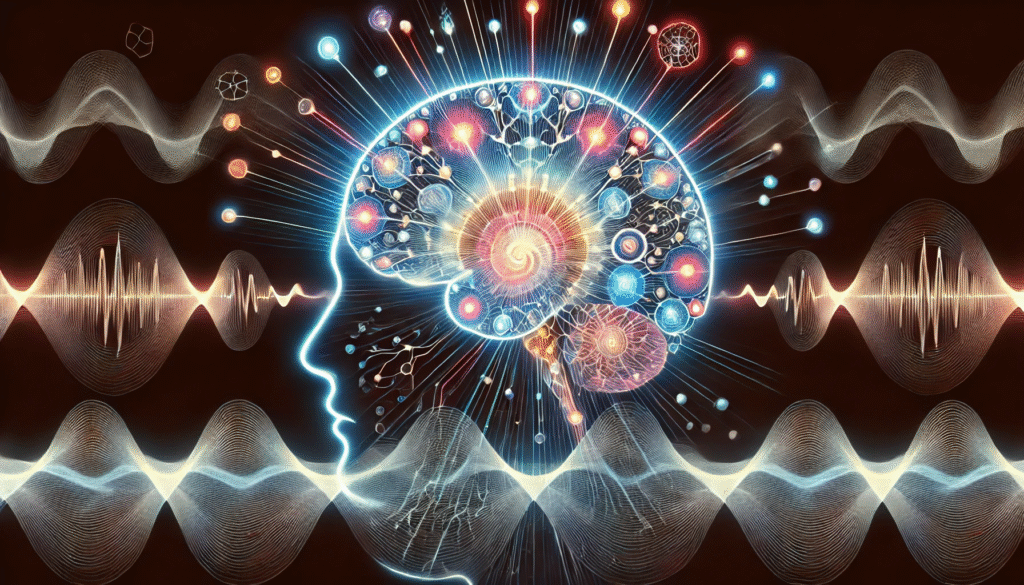
ChatGPT:
The Brain on Ravel’s
Boléro
Maurice Ravel’s Boléro is one of those rare pieces of music that seems both astonishingly simple and strangely overwhelming. Written in 1928, it consists of one repeating melody, one repeating rhythm, and a long, slow crescendo. Nothing really “happens” in the traditional musical sense—no harmonic twists, no dramatic changes of theme—yet the piece builds a kind of trance that can leave listeners breathless. From a brain perspective, Boléro is like a laboratory experiment in how rhythm, repetition, and sound can take over our nervous system.
The Pull of the Beat
The piece begins with a soft snare drum tapping out a mechanical rhythm, joined by a flute playing the melody. That snare never stops. To a neuroscientist, this is important. The basal ganglia and cerebellum, brain areas that handle timing and coordination, quickly lock onto the pulse. Even if you’re sitting still, your motor system is silently rehearsing movement. This is why people feel compelled to tap their feet or nod their heads—it’s not just habit, it’s wiring.
In clinical settings, therapists use this very principle: patients with Parkinson’s disease, for example, can walk more smoothly when given a steady beat to follow. In Boléro, the rhythm serves as a kind of physiological anchor, tying the listener’s body to the music whether they want it or not.
Repetition and the Pleasure of Knowing
Then comes the melody—a long, sinuous line that repeats again and again. At first you might think such sameness would bore the brain. In fact, our auditory cortex and hippocampus love this kind of predictability. They quickly learn the pattern, so the next entrance feels anticipated, almost inevitable.
But Ravel avoids dullness by changing the color of the melody each time. A flute gives way to a clarinet, then a bassoon, then a saxophone, trumpet, horn, strings, and so on. The notes are familiar, but the timbre is fresh. This balance of expectation and novelty tickles the brain’s reward system—especially the nucleus accumbens, which releases dopamine when something is both recognizable and slightly varied. It’s the same mechanism that makes the chorus of your favorite song so satisfying: you know what’s coming, and you’re still delighted when it arrives.
The Crescendo and Rising Tension
As the orchestra grows, so does the volume. Over the course of fifteen minutes, the music swells from a whisper to a roar. This simple trick has profound effects on the body. The gradual increase activates the autonomic nervous system, nudging heart rate, breathing, and skin conductance upward. It’s not sudden fright, like a cymbal crash in a horror movie, but a slow, irresistible build of tension.
The amygdala, which helps the brain detect emotional significance, interprets this swelling sound as urgency. By the climax, listeners often feel chills or goosebumps. This “frisson” response is a classic marker of strong emotional arousal—one that blends pleasure, awe, and even a hint of anxiety. The beauty of Boléro is that it delivers this rush in a safe, contained form. The orchestra may be overwhelming, but we know we are not in danger. The body learns what it feels like to ride tension up to its breaking point and then release.
Music and the Daydreaming Mind
Because the melody and rhythm are so predictable, Boléro does not demand full conscious attention after a few minutes. This frees the default mode network—a system of brain areas linked to daydreaming, imagination, and self-reflection. People often find their minds drifting while listening: old memories surface, fantasies unfold, questions of identity or direction emerge.
This is where Boléro becomes more than sound. It becomes a canvas for the self. The music moves relentlessly forward whether you focus or not, and that sense of inevitability allows you to wander inside your own head without losing touch with the external world. It’s not quite meditation, not quite storytelling, but something in between—a structured drift guided by rhythm and crescendo.
Why Boléro Feels Like Therapy
Taken together, these effects explain why Boléro can feel therapeutic. It engages the body through rhythm, stabilizing attention and movement. It provides pleasure through the balance of predictability and variety. It raises arousal in a controlled way, leading to cathartic release. And it opens the mind to personal reflection, giving space for imagery and memory to rise.
In music therapy, these are precisely the tools practitioners seek: grounding, stimulation, emotional processing, and self-discovery. Boléro happens to package them in one elegant experiment. Ravel himself supposedly joked that the piece was “orchestral tissue without music,” but from the standpoint of neuroscience, it might be better described as a distilled essence of what music does to the human brain.
How It Differs From Mahler
It’s illuminating to compare this with someone like Gustav Mahler, whose symphonies are full of abrupt contrasts, harmonic twists, and emotional extremes. Mahler keeps the listener’s attention networks busy—your brain must follow every shift, track recurring motifs, and reconcile sudden changes in mood. The pleasure comes from surprise and resolution, from the brain working hard to make sense of complexity.
Ravel, by contrast, asks for surrender. Once you’ve heard the melody, you know exactly what will happen. Your conscious mind can rest while your body and imagination take over. Mahler is like reading a rich novel; Boléro is like watching a slow, hypnotic wave. Both can be deeply moving, but they pull on different parts of the brain and the self.
A Window Into Ourselves
In the end, Boléro is not just about Ravel’s craft, but about our own nervous system. It shows how rhythm can grip the motor brain, how repetition can soothe and reward, how crescendos can stimulate emotion, and how predictability can free the mind for reflection. It demonstrates why music can feel like medicine: not because it tells us what to feel, but because it creates conditions for the body and mind to explore themselves.
When we let Boléro wash over us, we’re not only listening to an orchestra. We’re listening to our own brain at work—entrained, aroused, wandering, and finally released. That is the paradox of this deceptively simple piece: with so little material, it reveals so much about what it means to be human.

